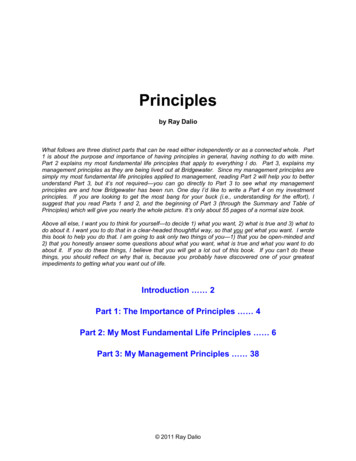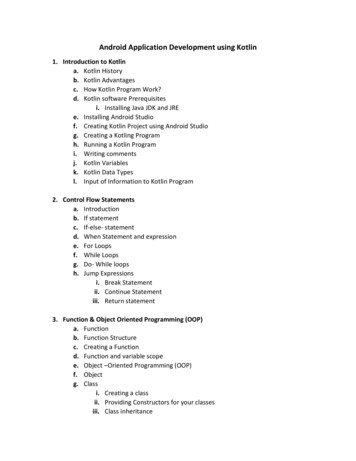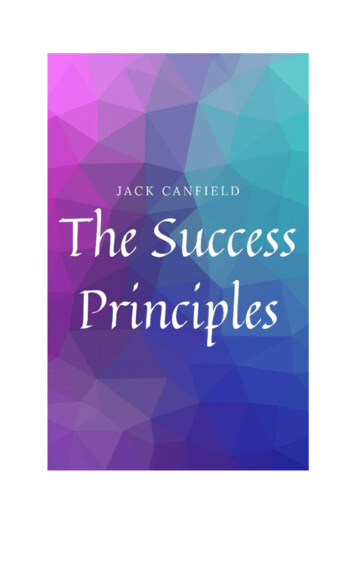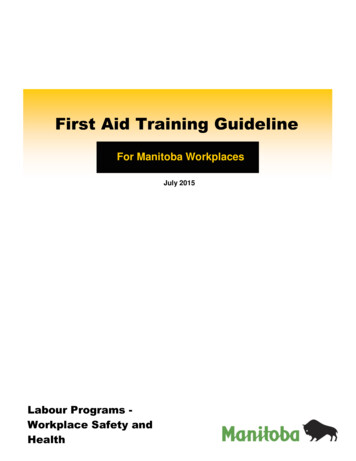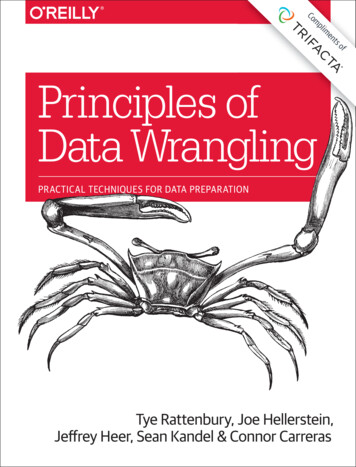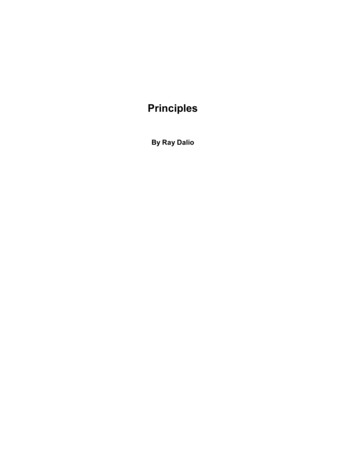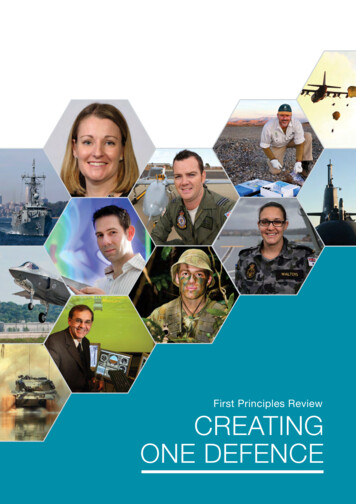
Transcription
First Principles ReviewCREATINGONE DEFENCE
First Principles ReviewCREATINGONE DEFENCE
2First Principles Review CREATING ONE DEFENCE
CONTENTSForeword5Key Recommendations7Specific Recommendations9Creating One DefenceChapter 1: One Defence – Case for Change11Chapter 2: One Defence – A Strong, Strategic Centre19Chapter 3: One Defence – Capability Development Life Cycle31Chapter 4: One Defence – Corporate and Military Enablers43Chapter 5: One Defence – Workforce53Optimising Resources and ImplementationChapter 6: One Defence – Optimising Resources and Dispelling Myths63Chapter 7: One Defence – Implementation71Annexes79A.Terms of Reference including alignment with recommendations81B.Framework for the First Principles Review of Defence89C.Recurring themes identified in recent reviews91D.Growth in Defence senior leadership numbers95E.Capability Development Life Cycle97F. Australian Public Service classifications and Australian Defence Force equivalent ranks99G.List of stakeholder interviews101H.Departmental Secretariat107First Principles Review CREATING ONE DEFENCE3
4First Principles Review CREATING ONE DEFENCE
FOREWORDI am pleased to present the Report of the First Principles Review Team.In August 2014, the previous Minister for Defence appointed the team to undertake the First Principles Review ofDefence. I was asked to chair the review team comprised of Professor Robert Hill, Professor Peter Leahy, Mr JimMcDowell and Mr Lindsay Tanner. The membership of the review team brought together a range of perspectives anda wealth of experience and expertise.We were ably supported by Roxanne Kelley, Major General Paul Symon and their secretariat1 as well as the BostonConsulting Group. The Secretary, Dennis Richardson and the Chief of the Defence Force, Mark Binskin are to becommended for their openness, professionalism and cooperation during the course of the review. I am extremelypleased that a quality outcome has been delivered in a tight timeframe.We were tasked with ensuring that Defence is fit for purpose and is able to deliver against its strategy with theminimum resources necessary. Using a structured framework, we have conducted an end-to-end holistic reviewbased on the outcomes required of Defence and founded on the first principles agreed by the review team. Simplyput we sought to answer the question, what is the most effective and efficient organisation that will enable Defence todeliver the outcomes required of it?Defence is an organisation with a long and deservedly proud history. Its evolutionary journey from separate singleService agencies into the Australian Defence Force and further into an increasingly integrated Defence Organisationcommenced in the 1970s. This report, in our opinion, sets out the next phase of change for Defence.Our work has been forward looking. We believe the review positions Defence to best meet the future demands onit. We present a sustainable and enduring business model, one that allows Defence to protect the nation and itsinterests whilst also delivering best public value.The recommendations are not revelations and many carry a familiarity with those coming from previous reviews.However, our review and its supporting analysis have led us to recommend transformational change to anorganisation which has drifted from contemporary best practice. In combination the recommendations will changethe structure, governance arrangements, accountabilities, processes and systems of Defence. They are designed tooperate as a whole and will need to be implemented as such in order to be most effective.The combined effect is a more unified and integrated organisation that is more consistently linked to its strategy andclearly led by its centre. We have called this, the One Defence approach. It has four key features: A stronger and more strategic centre able to provide clear direction, contestability of decision-making, along withenhanced organisational control of resources and monitoring of organisational performance; An end-to-end approach for capability development with Capability Managers having clear authority andaccountability as sponsors for the delivery of capability outcomes to time and budget, supported by an integratedcapability delivery function and subject to stronger direction setting and contestability from the centre;1Members of the Secretariat are listed at Annex H.First Principles Review CREATING ONE DEFENCE5
Enablers that are integrated and customer-centric with greater use of cross-functional processes, particularly inregional locations; and A planned and professional workforce with a strong performance management culture at its core.Effective implementation is essential to achieving the One Defence model and to generating the efficiencies thereview has identified. A high level implementation plan has also been developed. Successful delivery of the review’sintent will require a unified leadership team willing to drive change and a behavioural shift; a sense of urgency and awillingness to push the pace of change; and sufficient planning, oversight and commitment to delivering the full intentof recommendations. As the Secretary and the Chief of the Defence Force are recently appointed to their roles, thisprovides a good starting point for the implementation of our recommendations.The One Defence transformation is an opportunity for Defence to establish better relationships with the Government,Ministers, external stakeholders, central agencies, its own leadership and workforce. It is an opportunity forDefence to reset its reputation and re-position itself as a truly integrated agency that consistently produces the bestpublic value, and is able to meet the current and future demands on it. Most importantly, it will allow Defence toeffectively deliver on its primary focus: to protect and advance Australia’s strategic interests through the provision ofappropriately prepared and equipped armed forces.David PeeverChairFirst Principles Review of Defence6First Principles Review CREATING ONE DEFENCE
KEY RECOMMENDATIONSThis review of Defence from first principles has shown that a holistic, fully integrated One Defence system isessential if Defence is to deliver on its mission in the most effective and efficient way.In order to create One Defence and give effect to our first principles, we recommend Defence:1. Establish a strong, strategic centre to strengthen accountability and top level decision-making2. Establish a single end-to-end capability development function within the Department to maximise the efficient,effective and professional delivery of military capability3. Fully implement an enterprise approach to the delivery of corporate and military enabling services to maximisetheir effectiveness and efficiency4. Ensure committed people with the right skills are in appropriate jobs to create the One Defence workforce5. Manage staff resources to deliver optimal use of funds and maximise efficiencies6. Commence implementation immediately with the changes required to deliver One Defence in place withintwo yearsWe have also outlined 70 specific recommendations which detail the actions required to deliver these keyrecommendations.First Principles Review CREATING ONE DEFENCE7
8First Principles Review CREATING ONE DEFENCE
First Principles Review Recommendations1. Establish a strong strategic centre to strengthenaccountability and top level decision-makingWe recommend:2. Establish a single end-to-end capability development functionwithin the Department to maximise the efficient, effective andprofessional delivery of military capabilityWe recommend:1.1this review be adopted as the road map for Defence reform for the next five years2.1disbanding the Capability Development Group and dispersing its functions to more appropriate areas1.2a new One Defence business model2.21.3the diarchy is retaineddisbanding the Defence Materiel Organisation and transferring its core responsibilities in relation tocapability delivery to a new Capability Acquisition and Sustainment Group1.4the individual and shared accountabilities of the Secretary and the Chief of the Defence Force beclarified, formally documented and promulgated through the organisation2.31.5a streamlined top level management structure for the Department that is aligned with theOne Defence business model1.6the strategic centre include the Associate Secretary and Vice Chief of the Defence Force as theintegrators for the Defence enterprise and the future force and joint capabilities respectively1.7the Vice Chief of the Defence Force’s decision rights be greatly strengthened, including the right tostop projects proceeding through the approval process until joint force integration is proven1.8legislative changes to formally recognise the authority of the Chief of the Defence and the Vice Chiefof the Defence Force, including removing the statutory authority of the Service Chiefs1.9that policy advice be strengthened by bringing all policy functions into one organisational unit inorder to improve the quality of advice provided to Government1.10a strong and credible internal contestability function be built and led by the Deputy SecretaryPolicy and Intelligence with responsibility for strategic contestability, scope, technical and costcontestability1.11that the policy and intelligence functions be combined under a Deputy Secretary Policy andIntelligence, who will have responsibility for providing policy advice and intelligence assessments tothe Secretary and the Chief of the Defence Force3. Fully implement an enterprise approach to the delivery ofcorporate and military enabling services to maximise theireffectiveness and efficiencyWe recommend:3.1Defence define the estate need as determined by future force requirements and Government agreeto dispose of all unnecessary estate holdings starting with the 17 bases identified in the 2012 FutureDefence Estate Reportdeveloping a new organisational design and structure as part of the implementation process for theCapability Acquisition and Sustainment Group with reduced management layers3.2Defence strengthen its capability to present options to Government for estate disposal including obtainingexpert external advice as required2.4examining each System Program Office to determine where each fits within the smart buyer function, themost appropriate procurement model and achieving value for money3.32.5the Capability Managers specify the Fundamental Inputs to Capability requirements with the CapabilityAcquisition and Sustainment Group having responsibility for developing and delivering an integrated projectplanthe Government amend the Public Works Act 1969 to set a 75 million threshold for referring proposedworks to the Public Works Committee, and re-consider recent adjustments to the 2015-16 Budgetoperational rules that run counter to more efficiently managing investment spending3.42.6the accountability for requirements setting and management be transferred to the Vice Chief of theDefence Force and the Service Chiefs with strategic, financial and technical contestability being locatedwith Deputy Secretary Policy and Intelligencethe Associate Secretary be directed and resourced to implement enterprise information management thatprovides Defence with trusted information to inform decision-making and military interoperability, with theVice Chief of the Defence Force as the design authority for the next generation of Command, Control,Communications, Intelligence, Surveillance and Reconnaissance3.5the information management agenda be governed at the Band 3/3 Star level by the Enterprise BusinessCommittee to set overall direction and priorities, including the management of trade-offs and conflicts2.7that the Independent Project Performance Office and the Capability Investment and Resources Division berelocated to Deputy Secretary Policy and Intelligence, significantly enhanced and strengthened to providesuch contest3.6supporting the Chief Information Officer to meet these responsibilities by formally recognising the ChiefTechnology Officer as the technical authority with appropriate ‘red card’ decision rights2.8revising the Defence investment approval process for all large or complex capability projects3.7Defence establish enterprise-wide frameworks for architecture standards and master data management2.9introducing a new formal gate into the process at entry point - Gate Zero: Investment Portfolio entry3.82.10Government increase approval thresholds for capability development projects, with ministerial approvalrequired only for projects above 20 million, two ministers above 100 million and Cabinet above 250millionDefence embark on a pragmatic implementation road map to standardise business and informationprocesses and their supporting applications3.9Defence ensure adequate resourcing and funding for information management reform is prioritised as partof the fully costed 2015 Defence White Paper2.11significant investment to develop an operational framework which comprehensively explains how theorganisation operates and the roles and responsibilities within it; detailing the life cycle managementprocesses which provide project and engineering discipline to manage complex materiel procurementfrom initiation to disposal; and reviewing architecture to reinforce accountability at all levels and bringingtogether information upon which good management decisions can be made3.10geospatial information functions be consolidated into the Australian Geospatial-Intelligence Organisationfollowing improved resourcing and connectivity3.11the service delivery reform program, including full integration of the current Defence Materiel Organisationcorporate functions, be completed3.12all corporate services (with the exception of finance but including the Defence Security Authority) beconsolidated under the Associate Secretary3.13all military enabling services (Joint Logistics Command Policy, Joint Health Command, Australian DefenceCollege, Australian Civil-Military Centre) be consolidated under a Two-Star officer who reports to the ViceChief of the Defence Force1.12the Defence Security Authority be repositioned under the Associate Secretary1.13the Defence Committee be re-positioned as the primary decision making committee of Defenceand the heart of the strategic centre with two supporting committees – Enterprise BusinessCommittee and Investment Committee2.121.14that all other enterprise-wide committees be reviewed for their relevance and alignment with theOne Defence business model with the aim of a substantial reduction in the number of committeesthe Deputy Secretary Capability Acquisition and Sustainment must sign off and assure the Secretary of theoperational output of each of his/her divisions every quarter and on major contracts on a monthly basis2.13the use of net personnel operating costs process cease immediately1.15that the organisational structure reporting to the Vice Chief of the Defence Force be simplifiedthrough the incorporation of a two-star Head of Joint Enablers role2.14developing a Defence Investment Plan which would include all capital and related investments (such asmateriel, estate and facilities, workforce and information and communications technology)1.16a strengthened centre-led, enterprise-wide planning and performance monitoring process be adopted2.151.17that the Associate Secretary be the central authority to deliver enterprise planning and performancemonitoring processes, in line with the requirements of the Public Governance, Performance andAccountability Act 2013that, on Government approval, the entire project acquisition budget is allocated to the Capability Acquisition andSustainment Group to ensure expenditure is in accordance with the project delivery plan2.16the Defence Science and Technology Organisation be required to clearly articulate its value proposition.This would include examples and actual amounts of value created1.18that the Minister for Defence meet with the Defence Committee twice yearly to consider a formalstrategic assessment of the alignment between Defence’s strategy, funding and capability2.17the Defence Science and Technology Organisation become part of the Capability Acquisition andSustainment Group2.18the Defence Science and Technology Organisation senior leadership be rationalised1.19Defence conduct regular reviews of the capital program in consultation with the Minister andcentral agencies2.19the Defence Science and Technology Organisation strengthen partnerships with academic and researchinstitutions to leverage knowledge and create pathways with academia and industry2.20disbanding the Defence Science and Technology Organisation advisory board2.21Defence, in partnership with academia and industry, review its research priorities, their alignment withfuture force requirements and capacity to leverage allied partners to promote innovation4. Ensure committed people with the right skills are inappropriate jobs to create the One Defence workforce5. Manage staff resources to deliver optimal use of funds andmaximise efficiencies6. Commence implementation immediately with the changesrequired to deliver One Defence in place within two yearsWe recommend:We recommend:We recommend:4.1that as part of the budget and planning process, Defence build a strategic workforce plan for the enablingfunctions, and incorporate workforce plans for each job family in order to drive recruitment, learning anddevelopment, performance and talent management5.1the use of the measures such as the teeth-to-tail ratio and the one third budget split should cease5.2appropriate efficiency measures are developed which link to the delivery of agreed outcomes4.2Defence employ Australian Defence Force personnel in non-Service roles only when it is critical to achievingcapability and for a minimum of three years to achieve best value-for-money from the premium paid5.3the focus on public service reductions as the primary efficiency mechanism for Defence cease4.3as many functions as possible be performed by public servants or outsourced if they are transactionalin nature5.44.4Defence review the entirety of its enabling and military corporate workforce to ensure that it supportsthe Australian Defence Force with the minimum of overlap and redundancy, and with the greatest overalleconomy, efficiency and effectiveness5.54.5Defence reduce organisational layers; increase the spans of control of managers; align workforcestandards in accord with the requirements of the Australian Public Service Commission; and engageexternal assistance to facilitate this work as required4.6Defence implement a transparent performance management system that is consistently applied,recognises and rewards high performance and introduces consequences for underperformance andfailure to deal with it4.7as part of the performance management system, Defence take steps to create a culture whereleadership, professionalism and corporate behaviour are valued and rewarded6.1no additional reviews on the organisational issues covered by this Review are imposed on Defence,particularly within the early years of implementation6.2past reviews and current reform initiatives should be assessed for currency and alignment to theOne Defence modelDefence manage its workforce numbers in line with good resource management practice whereDefence is held to account for delivering on required outcomes within available resourcing6.3establishing an Oversight Board to provide close external scrutiny, advice on implementation progressand regular reports to the Ministeras part of the implementation process, Defence examine the headquarters functions for opportunities toachieve more effective and efficient arrangements6.4the Minister, with input from the Department and the Oversight Board, report progress onimplementation to the Government in March 2016 and March 20176.5stability in the key leadership positions, particularly over the next two years to provide consistency ofdirection and ownership of the changeFirst Principles Review CREATING ONE DEFENCE9
1Defence Geospatial Enterprise ReviewWraith (Fuel) ReviewDefence White Paper 6Air Force New HorizonsProject Accountability& AcquisitionPathway to ChangeSRP Extension& Shared ServicesDefence BudgetRealignmentExternal Reviewof DSDStrategic ReformProgramReview of DIODefence CapabilityPlan & DefencePlanning GuidanceNew Generation NavyReform to theManagement of theProjects of Concern ListBrady Review 2Air ForceImprovementAdaptive ArmyProust ReviewPappas ReviewBlack ReviewRizzo ReviewReview of theDefence Capability PlanColes ReviewOne DefenceCase for ChangeIndependent Reviewof theIntelligence CommunityPhase Six ReviewWhite Paper 5Brady Review 1Wilson ReviewReport of the Inquiryinto AustralianIntelligence Agencies Kinnaird ReviewDefence Reform ProgramDefence Governance,Acquisition and SupportReviewOrganisational RenewalAgendaDefence EfficiencyReviewSanderson ReviewWhite Paper 4White Paper 3Wrigley ReviewCross Review 2White Paper 2Cooksley ReviewDibb ReviewCross Review 1Utz ReviewWhite PaperTange ReviewCommercial Support Program
The First Principles Review of Defence was commissioned by the then Minister for Defence in August 2014 followingthe Government’s 2013 election commitment. We were tasked with ensuring that Defence is fit for purpose and isable to deliver against its strategy with the minimum resources necessary. The Terms of Reference for the review areat Annex A.2ApproachWe have taken a total systems approach based on evidence and analysis, sound principles and root causes ratherthan symptoms.Our framework for the review (see Annex B) ensured we addressed the Terms of Reference in a manner whichfocused on the entire Defence system, interacting with the broader government, business and community systems.We have conducted an end-to-end holistic review based on the outcomes required of Defence and founded on thefirst principles agreed by the review team (see Diagram 1).Diagram 1: First PrinciplesDEFENCE OUTCOMEFIRST PRINCIPLESProtect and advance Australia’sstrategic interests throughthe provision of appropriatelyprepared and equipped armedforces. To achieve this, Defenceprepares for and conductsmilitary operations and othertasks as directed by theGovernment.3 Clear authorities and accountabilities that align with resources Decision-makers are empowered and held responsible for delivering on strategies and planswithin agreed resourcing Outcome orientation Delivering what is required with processes, systems and tools being the ‘means not the end’ Simplicity Eliminating complicated and unnecessary structures, processes, systems and tools Focus on core business Defence doing only for itself what no one else can do more effectively and efficiently Professionalism Committed people with the right skills in appropriate jobs Timely, contestable advice Using internal and external expertise to provide the best advice so that the outcome is deliveredin the most cost-effective and efficient manner Transparency Honest and open behaviour which enables others to know exactly what Defence is doingand why3We considered the enduring tasks of Defence whilst recognising the changing future context that Defence will needto operate within. Then through the lens of the first principles we considered what is required to fulfil theseresponsibilities. We have focused specifically on the areas of: direction setting and control; provision of policy adviceand intelligence; capability development, acquisition and sustainment; and the key enablers (informationmanagement, estate, service delivery and the workforce). We have conducted wide-ranging interviews withstakeholders and have been supported by the Boston Consulting Group and a small departmental secretariat.2 Annex A also includes the review recommendations aligned with the Terms of Reference and National Commission of Audit Defencerecommendations.3 Department of Defence, Portfolio Budget Statements 2014 - 15, Budget Related Paper no. 1.4A, 2014, p. 15, available at www.defence.gov.au/budget/14–15/PBS.asp .12First Principles Review CREATING ONE DEFENCE
Why another review?Since the 1973 Tange Review, there have been over 35 significant reviews and many more supplementary reviews ofDefence (see Annex C).4 The sheer frequency of reviews over the past decade has meant that many were short-livedor simply overtaken by the next review. Often the recommended changes were not allowed to bed in before anotherreview began.Despite this, Defence has implemented significant changes and improvements since the 1990s, for example,recommendations associated with the Kinnaird, Mortimer, Coles and Rizzo reviews along with the Pathway to Changeinitiatives. Compared to a decade ago, Defence has better governance and greater transparency. It has delivered onsome difficult efficiency targets and has a more capable Australian Defence Force and Defence system generally.Defence has a long history of effectively delivering militarily for Australia but faces great challenges over the nextten to twenty years. It must deliver a significant capability modernisation program against a backdrop of strategicuncertainty including, but not limited to: rapid technological change; budget uncertainty; substantial economic growthin our region; and increasing demand for military responses to various regional and expeditionary crises.Notwithstanding previous reviews and reforms, both the Government and senior leaders in Defence recognise thatthe organisation needs to work much more effectively and that Defence in its current form is not best organised tomeet these challenges. This is the focus of our review.The problemThere is general agreement about the nature of the problem.5 The current organisational model and processes arecomplicated, slow and inefficient in an environment which requires simplicity, greater agility and timely delivery. Waste,inefficiency and rework are palpable.Defence is suffering from a proliferation of structures, processes and systems with unclear accountabilities. These inturn cause institutionalised waste, delayed decisions, flawed execution, duplication, a change-resistant bureaucracy,over-escalation of issues for decision and low engagement levels amongst employees.Previous reviews and interviews with stakeholders indicate Defence operates as a loose federation where theindividual parts from the highest levels, then down and across the organisation, are strongly protective of their turfand see themselves meriting more favour than other parts of the department. The centre is weak and notsufficiently strategic.The problem is illustrated by the following examples: The number of senior leaders has nearly doubled, growing from 201 in 1998 to 374 in 2014 (an 86 per centincrease), while the total number of other staff has risen from around 73,000 to 78,000 (an increase of seven percent - see Annex D); There are around 200 active committees in the organisation; There are up to twelve layers in some parts of the organisational structure against good practice of around seven;6 Eighty per cent of managers supervise less than five staff with sixty per cent of these supervising either one or twostaff members. Good practice would see managers supervising between five and eight staff;74 The significant reviews are listed in Annex C, along with a summary of recurring themes in capability development and a timeline of reviewssince 1973.5 We formed our views following interviews with stakeholders and consideration of a range of recent reports to Parliament by its Committees andby the Australian National Audit Office.6 From briefing material provided by the Australian Public Service Commission to the Secretaries’ Board, October 2014, and theBoston Consulting Group, augmented with analysis of Defence personnel data.7ibid.Chapter 1 One Defence A Case for Change13
Capability development is a series of hand-off points between different parts of the organisation involving around7000 Defence staff spread across seven organisational units: the three Services, the Vice Chief of the Defence Force,Defence Science and Technology Organisation, Capability Development Group and Defence Materiel Organisation; The setting of needs and requirements is poor with priority given to single Service needs over joint projects. While16 per cent of major capital equipment funding has been allocated to joint projects, actual expenditure is betweenfour and nine per cent demonstrating that less priority is given to joint projects;8 Costing methodology does not account for all of the inputs to capability, at acquisition and over project life, andthe true total cost of ownership is opaque;9 Project approval processes are lengthy and expensive. The average government submission is 70 pages long,takes 16 weeks to move through the Cabinet preparation process and an average of 46 months to progress fromfirst pass initiation through to second pass approval;10 Acquisition teams must comply with over 10,000 Defence Materiel Organisation specific policies and procedures whichincludes 35 policy and procedure artefacts totalling around 12,500 pages on procurement processes and controls;11 There is a ‘one size fits all’ approach to procurement strategy that inhibits strategic engagement with industry;12 Defence has a larger estate footprint than it needs because of significant internal and external blockages toremoving redundant parts of the estate; and Duplicated systems and processes reflect entrenched resistance to implementing businesslike approaches suchas shared corporate services and the empowerment of single accountable officers in areas such as informationmanagement. According to the Chief Information Officer, Defence has over 2500 information and communicationmanagement applications including 300 financial applications.Previous review themesPrevious reviews, more frequent s
We were ably supported by Roxanne Kelley, Major General Paul Symon and their secretariat1 as well as the Boston Consulting Group. The Secretary, Dennis Richardson and the Chief of the Defence Force, Mark Binskin are to be commended for their openness, professionalism and co
